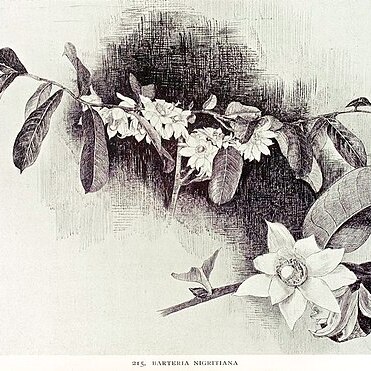Shrub or tree to ± 10 (outside E. Africa up to 25) m., sometimes deciduous; stem up to 30(–50) cm. in diameter; bark whitish, rough.. Leaf-blades variable in shape, elliptic to oblong or ovate-oblong, or oblanceolate, base rounded to long-cuneate (especially in terminal leaves), top ± obtuse to acute, or acuminate up to 2 cm., 10–30(–45) by 4–10(–19) cm., subcoriaceous, glabrescent or glabrous; nerves 9–19 pairs, ± prominent on both sides; petiole 5–10(–15) mm. long, 2–8 mm. wide, mostly shortly winged and decurrent on the branchlets as a low ridge.. Inflorescences 1–4-flowered, or outside E. Africa up to 9-flowered; bracts orbicular to ovate, obtuse or shortly acuminate, 3–15 mm. long, outside ferrugineous pubescent or glabrous, margin ciliate.. Flowers large, white.. Sepals elliptic to oblong, acuminate, 2.5–4 by 1–1.5 cm., ferrugineous silky or glabrescent outside.. Petals resembling the sepals, equal in size or either somewhat smaller or larger, mucronate.. Outer corona membranous, ± 1 cm. high; inner corona a fleshy, shallowly lobed, 3–5 mm. high rim.. Stamens ± 3 cm.; filaments connate for nearly half-way, glabrous; anthers 3–6 mm.. Ovary glabrous, subglobose or with (3–)4–5 bulges in the upper part; style 10–20 mm.; stigma conical to subglobose, yellow.. Fruit green-yellow to dull orange or reddish, ± 1.5–3 cm. in diameter.
More
Flowers white, sweet-scented, with a large mushroom-shaped yellow stigma
Branchlets with spindle-shaped swellings occupied by stinging ants
A tree, 10–20 ft. high, rarely to 45 ft.


